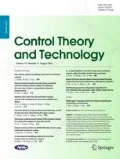
References
Bonin, M., Seghezza, V., & Piroddi, L. (2010). LASSO-enhanced simulation error minimization method for NARX model selection. In Proceedings of the American control conference, (pp. 4522–4527) Baltimore, MD, USA.
Chiuso, A., & Pillonetto, G. (2014). Bayesian and nonparametric methods for system identification and model selection. In Proceedings of the 13th European control conference (pp. 2376–2381). Strasbourg, France.
Morici, S., Spiriti, E., & Piroddi, L. (2013). An indirect model selection algorithm for nonlinear active noise control. In Proceedings of the 12th European control conference (pp. 2910–2915). Zurich, Switzerland.
Xiong, D., Chai, L., & Zhang, J. (2014). Sparse system identification using orthogonal rational functions. In Proceeding of the 11th World congress on intelligent control and automation (pp. 2340–2345). Shenyang, China.
Candes, E., & Tao, T. (2006). Near optimal signal recovery from random projections: Universal encoding strategies? IEEE Transactions on Information Theory, 52(12), 5406–5425.
Roweis, S. T., & Saul, L. K. (2000). Nonlinear dimensionality reduction by locally linear embedding. Science, 290(5500), 2323–2326.
Knight, K., & Fu, W. (2000). Asymptotics for Lasso-type estimators. The Annals of Statistics, 28, 1356–1378.
Zou, H. (2006). The adaptive Lasso and its oracle properties. Journal of the American Statistical Association, 101(476), 1418–1429.
Debruyne, M., Hubert, M., & Suykens, J. A. K. (2008). Model selection in kernel based regression using the influence function. Journal of Machine Learning Research, 9, 2377–2400.
Ojeda, F., Falck, T., De Moor, B., & Suykens, J. A. K. (2010). Polynomial componentwise LS-SVM: fast variable selection using low rank updates. In Proceedings of the 2010 international joint conference on neural networks (pp. 1–7). Barcelona, Spain.
Chen, H. F., & Guo, L. (1991). Identification and stochastic adaptive control. Boston: Birkhäuser.
Ljung, L. (1987). System identification: theory for users. Englewood Cliffs: Prentice Hall.
Perepu, S. K., & Tangirala, A. K. (2015). Identification of equation error models from small samples using compressed sensing techniques. IFAC-PapersOnline, 48(8), 795–800.
Kopsinis, Y., Slavakis, K., & Theodoridis, S. (2010). Online sparse system identification and signal reconstruction using projections onto weighted \(L_1\) balls. IEEE Transactions on Signal Processing, 59(3), 936–952.
Donoho, D. L. (2006). Compressed sensing. IEEE Transactions on Information Theory, 52(4), 1289–1306.
Marjanovic, G., & Solo, V. (2012). On \(l_q\) optimization and matrix completion. IEEE Transactions on Signal Processing, 60(11), 5714–5724.
Tóth, R., Sanandaji, B.M., Poolla, K., & Vincent, T.L. (2012). Compressive system identification in the linear time-invariant framework. In Proceedings of IEEE conference on decision and control and European control conference, (pp. 783–790). Orlando, FL, USA.
Gu, Y., Jin, J., & Mei, S. (2009). \(l_0\) norm constraint LMS algorithm for sparse system identification. IEEE Signal Processing Letters, 16(9), 774–777.
Kalouptsidis, N., Mileounis, G., Babadi, B., & Tarokh, V. (2011). Adaptive algorithms for sparse system identification. Signal Processing, 91(8), 1910–1919.
Cai, J., Luo, J., Wang, S., & Yang, S. (2018). Feature selection in machine learning: A new perspective. Neurocomputing, 300, 70–79.
Chen, J., Stern, M., Wainwright, M. J., & Jordan, M. I. (2018). Kernel feature selection via conditional covariance minimization. arxiv:1707.01164.
Song, L., Smola, A., Gretton, A., Bedo, J., & Borgwardt, K. (2012). Feature selection via dependence maximization. Journal of Machine Learning Research, 13, 1393–1434.
Feng, J. & Simon, N. (2019). Sparse-input neural networks for high-dimensional nonparametric regression and classification. arxiv:1711.07592.
Lemhadri, I., Ruan, F., Abraham, L., & Tibshirani, R. (2021). Lassonet: A neural network with feature sparsity. arxiv:1907.12207
Lei, Q., Yen, I. E., Wu, C., Dhillon, I. S., & Ravikumar, P. (2017). Doubly greedy primal-dual coordinate descent for sparse empirical risk minimization. In Proceedings of the 34th International conference on machine learning (pp. 2034–2042). Sydney, Australia.
Koltchinskii, V. (2009). Sparsity in penalized empirical risk minimization. Annales de l’Institut Henri Poincar, Probabilits et Statistiques, 45(1), 7–57.
Tibshirani, R. (1996). Regression shrinkage and selection via the lasso: a retrospective. Journal of the Royal Statistical Society, Series B: Methodological, 73, 273–282.
Efron, B., Hastie, T., Johnstone, I., & Tibshirani, R. (2004). Least angle regression. The Annals of Statistics, 32, 407–499.
Pillonetto, G., Chen, T., & Ljung, L. (2013). Kernel-based model order selection for identification and prediction of linear dynamic systems. In Proceedings of the 52nd IEEE conference on decision and control (pp. 5174–5179). Florence, Italy.
Brunton, S. L., Proctor, J. L., & Kutz, J. N. (2016). Discovering governing equations from data by sparse identification of nonlinear dynamical systems. Proceedings of the National Academy of Sciences, 113(15), 3932–3937.
Simon, N., Friedman, J., Hastie, T., & Tibshirani, R. (2013). A sparse-group lasso. Journal of Computational and Graphical Statistics, 22(2), 231–245.
Peng, H., Long, F., & Ding, C. (2005). Feature selection based on mutual information criteria of max-dependency, max-relevance, and min-redundancy. IEEE Transactions on Pattern Analysis and Machine Intelligence, 27(8), 1226–1238.
Tuv, E., Borisov, A., Runger, G., & Torkkola, K. (2009). Feature selection with ensembles, artificial variables, and redundancy elimination. Journal of Machine Learning Research, 10, 1341–1366.
Yamada, M., Jitkrittum, W., Sigal, L., Xing, E. P., & Sugiyama, M. (2014). High-dimensional feature selection by feature-wise kernelized lasso. Neural Computation, 26(1), 185–207.
Cheng, C., & Bai, E. (2021). Variable selection based on squared derivative averages. Automatica, 127, 109491.
Zhao, W., Yin, G., & Bai, E. (2020). Sparse system identification for stochastic systems with general observation sequences. Automatica, 121, 109162.
Author information
Authors and Affiliations
Corresponding author
Rights and permissions
About this article
Cite this article
Zhao, W. Sparse parameter identification of stochastic dynamical systems. Control Theory Technol. 20, 139–141 (2022). https://doi.org/10.1007/s11768-021-00077-5
Received:
Accepted:
Published:
Issue Date:
DOI: https://doi.org/10.1007/s11768-021-00077-5

